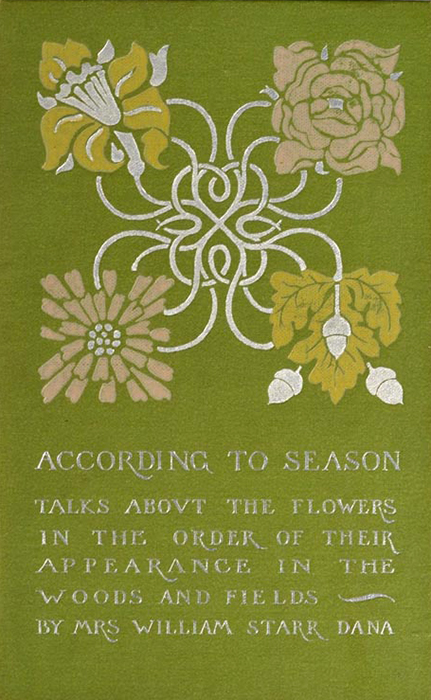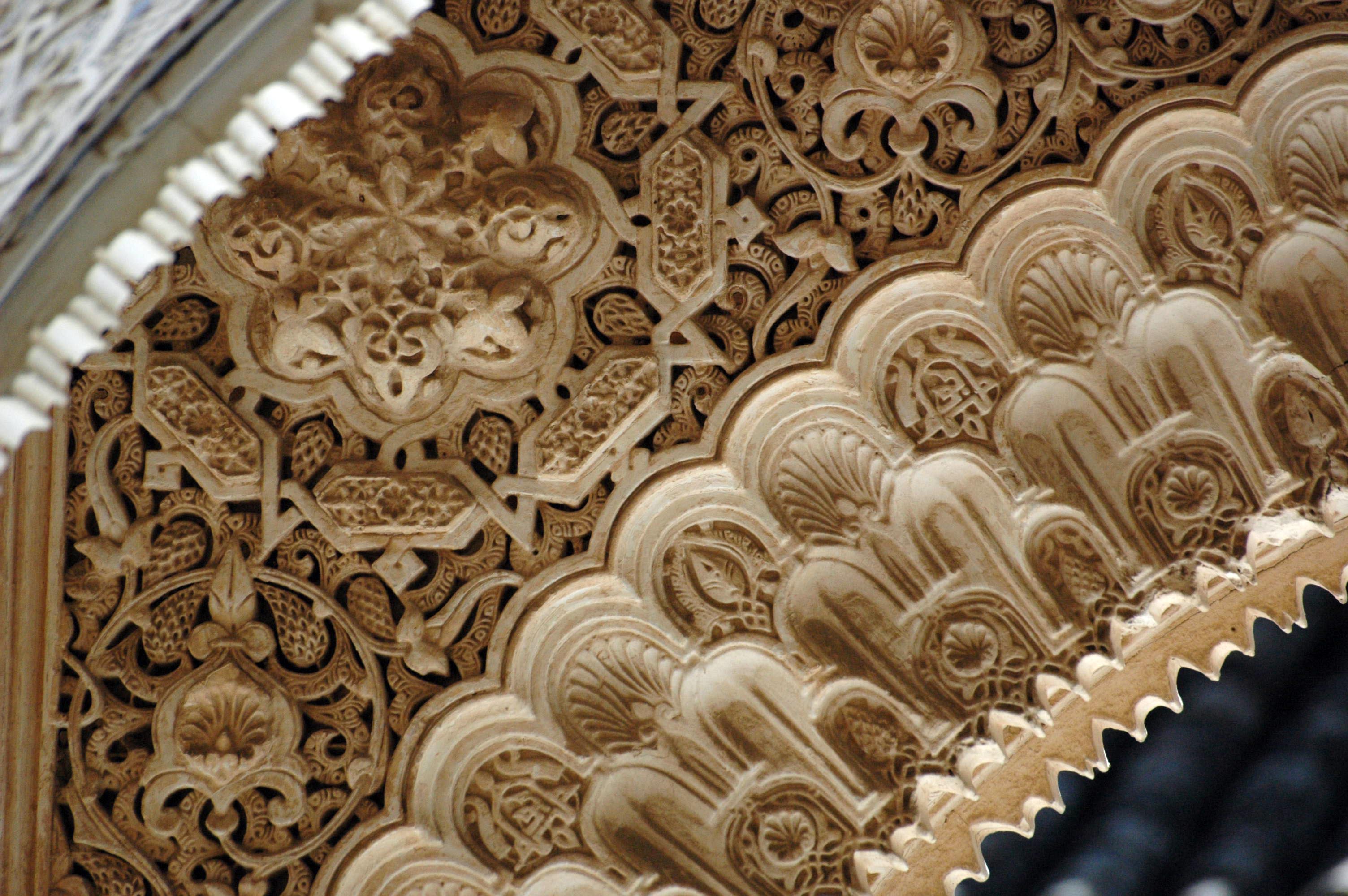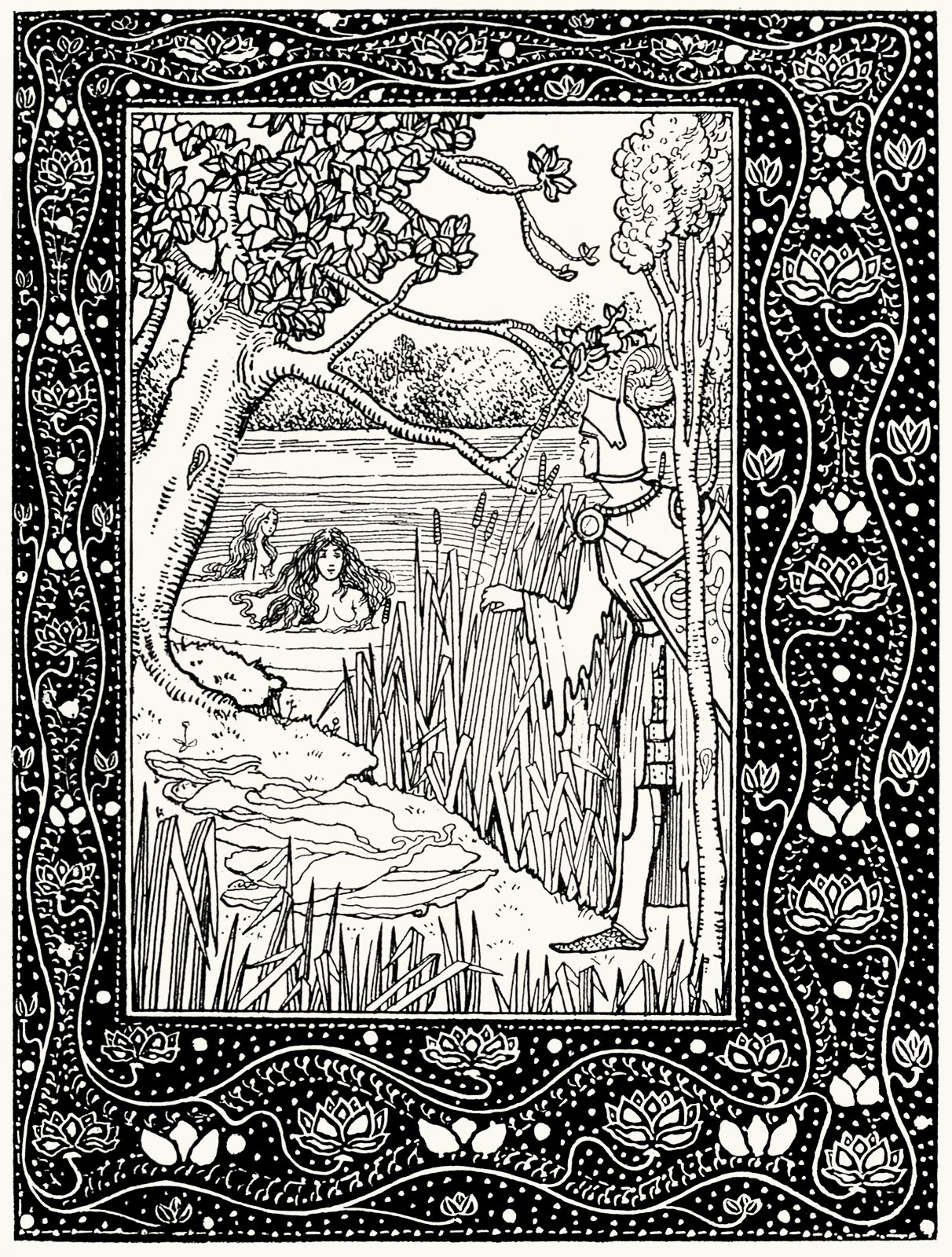|
Alice Cordelia Morse
Alice Cordelia Morse (June 1, 1863 – July 15, 1961) was an American designer of book covers in the late 19th and early 20th centuries. Her work was inspired by the Arts and Crafts Movement, and she is often placed as one of the top three book designers of her day. Early life and education Morse was born in Hammondsville, Ohio, to Joseph and Ruth Perkins. She had a brother, Joseph Jr., and a sister, Mary. When she was two, the family moved to Williamsburg, Brooklyn. Her early drawings failed to reveal any special talent. Morse attended the Woman's School of Art at Cooper Union from 1879 to 1883, graduating with a degree in art and design. Cooper Union was one of the few arts schools open to women in the late 1800s. Although some students paid tuition, Cooper Union would often waive fees for students who were unable to pay; it is likely that Morse was one of these students. After leaving Cooper Union, Morse studied at various art schools, including Alfred State College in Ne ... [...More Info...] [...Related Items...] OR: [Wikipedia] [Google] [Baidu] |
Hammondsville, Ohio
Hammondsville is an unincorporated area, unincorporated community in central Saline Township, Jefferson County, Ohio, Saline Township, Jefferson County, Ohio, Jefferson County, Ohio, United States. It is part of the Weirton–Steubenville metropolitan area. It lies along Ohio State Route 213. History Hammondsville was laid out in 1852 and named for Charles Hammond (lawyer and journalist), Charles Hammond, the original owner of the town site. A post office has been in operation at Hammondsville since 1852. Hammondsville was originally a mining community and the Hammondsville Mining and Coal Company operated there. Education Hammondsville is part of the Edison Local School District. Campuses serving the community includStanton Elementary School(Preschool-Grade 8) and Edison High School (Richmond, Ohio), Edison High School](Grades 9-12). Notable people * Bevo Francis, basketball player, one of the most prolific scorers in NCAA basketball, college basketball history References ... [...More Info...] [...Related Items...] OR: [Wikipedia] [Google] [Baidu] |
Lafcadio Hearn
, born Patrick Lafcadio Hearn (; el, Πατρίκιος Λευκάδιος Χέρν, Patríkios Lefkádios Chérn, Irish language, Irish: Pádraig Lafcadio O'hEarain), was an Irish people, Irish-Greeks, Greek-Japanese people, Japanese writer, translator, and teacher who introduced the culture and literature of Japan to the Western world, West. His writings offered unprecedented insight into Japanese culture, especially his collections of Japanese mythology, legends and kwaidan, ghost stories, such as ''Kwaidan: Stories and Studies of Strange Things''. Before moving to Japan and becoming a Japanese citizen, he worked as a journalist in the United States, primarily in Cincinnati and New Orleans. His writings about New Orleans, based on his decade-long stay there, are also well-known. Hearn was born on the Greek island of Lefkada, after which a complex series of conflicts and events led to his being moved to Dublin, where he was abandoned first by his mother, then his father, and f ... [...More Info...] [...Related Items...] OR: [Wikipedia] [Google] [Baidu] |
Sarah W
Sarah (born Sarai) is a biblical matriarch and prophetess, a major figure in Abrahamic religions. While different Abrahamic faiths portray her differently, Judaism, Christianity, and Islam all depict her character similarly, as that of a pious woman, renowned for her hospitality and beauty, the wife and half-sister of Abraham, and the mother of Isaac. Sarah has her feast day on 1 September in the Catholic Church, 19 August in the Coptic Orthodox Church, 20 January in the LCMS, and 12 and 20 December in the Eastern Orthodox Church. In the Hebrew Bible Family According to Book of Genesis 20:12, in conversation with the Philistine king Abimelech of Gerar, Abraham reveals Sarah to be both his wife and his half-sister, stating that the two share a father but not a mother. Such unions were later explicitly banned in the Book of Leviticus (). This would make Sarah the daughter of Terah and the half-sister of not only Abraham but Haran and Nahor. She would also have been the aunt ... [...More Info...] [...Related Items...] OR: [Wikipedia] [Google] [Baidu] |
Margaret Neilson Armstrong
Margaret Neilson Armstrong (1867–1944) was a 19th and early 20th-century American book cover designer, illustrator, and author. She is best known for her book covers influenced by Art Nouveau. She also wrote and illustrated the first comprehensive guide to wildflowers of the American west, ''Field Book of Western Wild Flowers'' (1915). In later life, she wrote two popular biographies and three mystery novels. Life Margaret Neilson Armstrong was born on September 24, 1867, in New York City, the daughter of American diplomat and stained glass artist Maitland Armstrong and his wife Helen, who was a descendant of Peter Stuyvesant and a niece of Hamilton Fish. Her six siblings included Helen Maitland Armstrong (1869–1948), who followed in her father's footsteps to become a stained glass artist, and Hamilton Fish Armstrong, long-time editor of ''Foreign Affairs'' magazine. She began her career as a book cover designer in the late 1880s, initially doing commissions for Charles Sc ... [...More Info...] [...Related Items...] OR: [Wikipedia] [Google] [Baidu] |
Art Nouveau
Art Nouveau (; ) is an international style of art, architecture, and applied art, especially the decorative arts. The style is known by different names in different languages: in German, in Italian, in Catalan, and also known as the Modern Style (British Art Nouveau style), Modern Style in English. It was popular between 1890 and 1910 during the Belle Époque period, and was a reaction against the academic art, eclecticism and historicism of 19th century architecture and decoration. It was often inspired by natural forms such as the sinuous curves of plants and flowers. Other characteristics of Art Nouveau were a sense of dynamism and movement, often given by asymmetry or whiplash lines, and the use of modern materials, particularly iron, glass, ceramics and later concrete, to create unusual forms and larger open spaces.Sembach, Klaus-Jürgen, ''L'Art Nouveau'' (2013), pp. 8–30 One major objective of Art Nouveau was to break down the traditional distinction between fine ... [...More Info...] [...Related Items...] OR: [Wikipedia] [Google] [Baidu] |
Rococo
Rococo (, also ), less commonly Roccoco or Late Baroque, is an exceptionally ornamental and theatrical style of architecture, art and decoration which combines asymmetry, scrolling curves, gilding, white and pastel colours, sculpted moulding, and ''trompe-l'œil'' frescoes to create surprise and the illusion of motion and drama. It is often described as the final expression of the Baroque movement. The Rococo style began in France in the 1730s as a reaction against the more formal and geometric Louis XIV style. It was known as the "style Rocaille", or "Rocaille style". It soon spread to other parts of Europe, particularly northern Italy, Austria, southern Germany, Central Europe and Russia. It also came to influence the other arts, particularly sculpture, furniture, silverware, glassware, painting, music, and theatre. Although originally a secular style primarily used for interiors of private residences, the Rococo had a spiritual aspect to it which led to its widespread use in ... [...More Info...] [...Related Items...] OR: [Wikipedia] [Google] [Baidu] |
Gothic Art
Gothic art was a style of medieval art that developed in Northern France out of Romanesque art in the 12th century AD, led by the concurrent development of Gothic architecture. It spread to all of Western Europe, and much of Northern, Southern and Central Europe, never quite effacing more classical styles in Italy. In the late 14th century, the sophisticated court style of International Gothic developed, which continued to evolve until the late 15th century. In many areas, especially Germany, Late Gothic art continued well into the 16th century, before being subsumed into Renaissance art. Primary media in the Gothic period included sculpture, panel painting, stained glass, fresco and illuminated manuscripts. The easily recognizable shifts in architecture from Romanesque to Gothic, and Gothic to Renaissance styles, are typically used to define the periods in art in all media, although in many ways figurative art developed at a different pace. The earliest Gothic art was monumental ... [...More Info...] [...Related Items...] OR: [Wikipedia] [Google] [Baidu] |
Arabic Art
Islamic art is a part of Islamic culture and encompasses the visual arts produced since the 7th century CE by people who lived within territories inhabited or ruled by Muslim populations. Referring to characteristic traditions across a wide range of lands, periods, and genres, Islamic art is a concept used first by Western art historians since the late 19th century. Public Islamic art is traditionally non- representational, except for the widespread use of plant forms, usually in varieties of the spiralling arabesque. These are often combined with Islamic calligraphy, geometric patterns in styles that are typically found in a wide variety of media, from small objects in ceramic or metalwork to large decorative schemes in tiling on the outside and inside of large buildings, including mosques. Other forms of Islamic art include Islamic miniature painting, artefacts like Islamic glass or pottery, and textile arts, such as carpets and embroidery. The early developments of Islamic a ... [...More Info...] [...Related Items...] OR: [Wikipedia] [Google] [Baidu] |
Celtic Art
Celtic art is associated with the peoples known as Celts; those who spoke the Celtic languages in Europe from pre-history through to the modern period, as well as the art of ancient peoples whose language is uncertain, but have cultural and stylistic similarities with speakers of Celtic languages. Celtic art is a difficult term to define, covering a huge expanse of time, geography and cultures. A case has been made for artistic continuity in Europe from the Bronze Age, and indeed the preceding Neolithic age; however archaeologists generally use "Celtic" to refer to the culture of the European Iron Age from around 1000 BC onwards, until the conquest by the Roman Empire of most of the territory concerned, and art historians typically begin to talk about "Celtic art" only from the La Tène culture, La Tène period (broadly 5th to 1st centuries BC) onwards. Early Celtic art is another term used for this period, stretching in Britain to about 150 AD. The Early Medieval art of Britain ... [...More Info...] [...Related Items...] OR: [Wikipedia] [Google] [Baidu] |
Renaissance
The Renaissance ( , ) , from , with the same meanings. is a period in European history marking the transition from the Middle Ages to modernity and covering the 15th and 16th centuries, characterized by an effort to revive and surpass ideas and achievements of classical antiquity. It occurred after the Crisis of the Late Middle Ages and was associated with great social change. In addition to the standard periodization, proponents of a "long Renaissance" may put its beginning in the 14th century and its end in the 17th century. The traditional view focuses more on the early modern aspects of the Renaissance and argues that it was a break from the past, but many historians today focus more on its medieval aspects and argue that it was an extension of the Middle Ages. However, the beginnings of the period – the early Renaissance of the 15th century and the Italian Proto-Renaissance from around 1250 or 1300 – overlap considerably with the Late Middle Ages, conventionally da ... [...More Info...] [...Related Items...] OR: [Wikipedia] [Google] [Baidu] |
Title Page
The title page of a book, thesis or other written work is the page at or near the front which displays its title (publishing), title, subtitle, author, publisher, and edition, often artistically decorated. (A half title, by contrast, displays only the title of a work.) The title page is one of the most important parts of the "front matter" or "preliminaries" of a book, as the data on it and its verso (together known as the "title leaf") are used to establish the "title proper and usually, though not necessarily, the statement of responsibility and the data relating to publication". This determines the way the book is cited in library catalogs and academic references. The title page often shows the title of the work, the person or body responsible for its intellectual content, and the imprint, which contains the name and address of the book's publisher and its date of publication. Particularly in paperback editions it may contain a shorter title than the cover or lack a descriptiv ... [...More Info...] [...Related Items...] OR: [Wikipedia] [Google] [Baidu] |
Vignette (graphic Design)
A vignette, in graphic design, is a French loanword meaning a unique form for a frame to an image, either illustration or photograph. Rather than the image's edges being rectilinear, it is overlaid with decorative artwork featuring a unique outline. This is similar to the use of the word in photography, where the edges of an image that has been vignetted are non-linear or sometimes softened with a mask – often a darkroom process of introducing a screen. An oval vignette is probably the most common example. Originally a vignette was a design of vine-leaves and tendrils (''vignette'' = small vine in French). The term was also used for a small embellishment without border, in what otherwise would have been a blank space, such as that found on a title-page, a headpiece or tailpiece. The use in modern graphic design is derived from book publishing techniques dating back to the Middle Ages Analytical Bibliography (ca. 1450 to 1800) when a vignette referred to an engraved desi ... [...More Info...] [...Related Items...] OR: [Wikipedia] [Google] [Baidu] |







.jpg)

